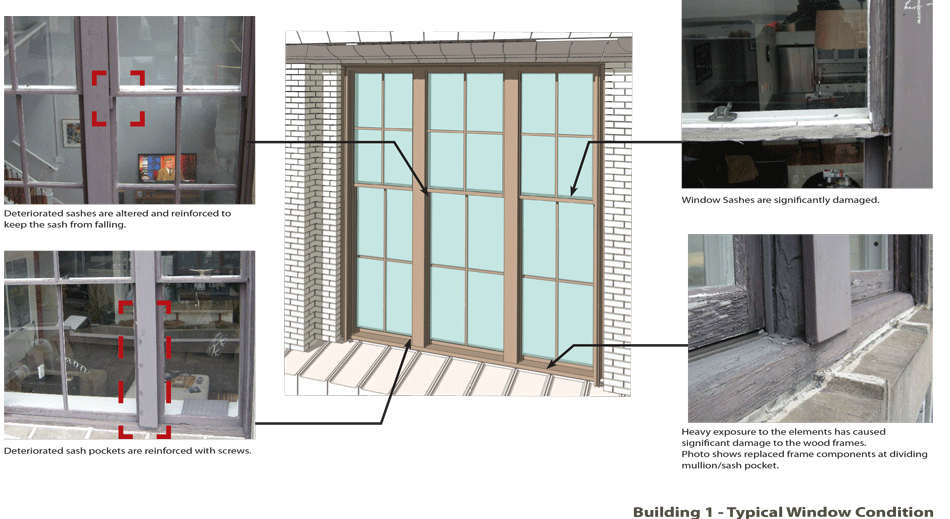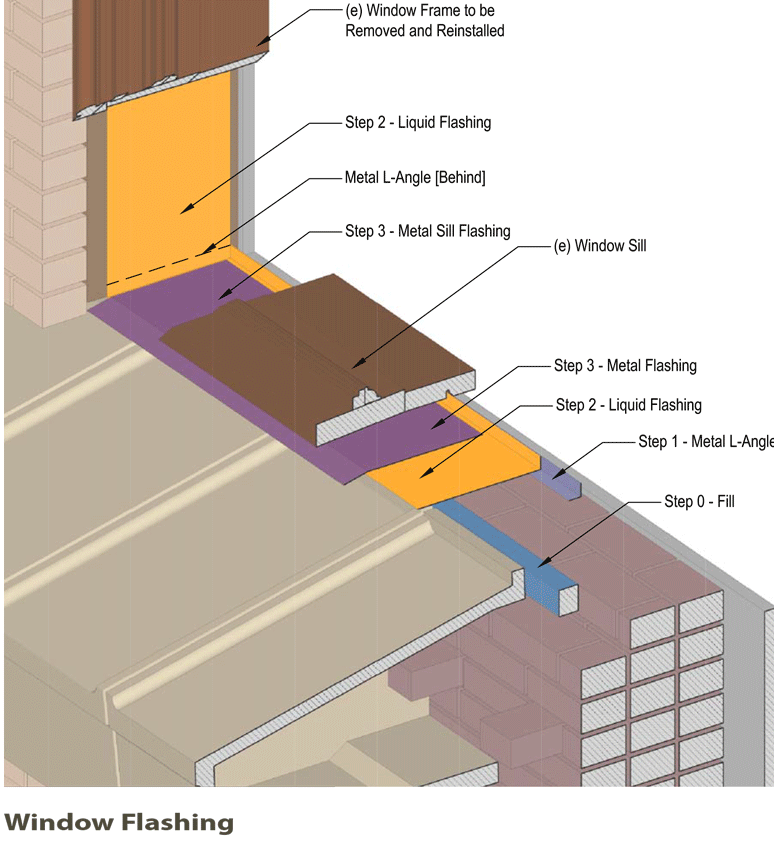 Our first choice, and ethical preference, is to retain historic wood windows. Repaired and maintained wood windows constructed of old growth lumber will outlast any modern alternative. We advocate strongly for a process and philosophy that seriously evaluates retaining original material. The best approach compares long-term costs, embodied energy, and cultural importance relative to the same criteria for new replacement material.
Our first choice, and ethical preference, is to retain historic wood windows. Repaired and maintained wood windows constructed of old growth lumber will outlast any modern alternative. We advocate strongly for a process and philosophy that seriously evaluates retaining original material. The best approach compares long-term costs, embodied energy, and cultural importance relative to the same criteria for new replacement material.
But what do you do when the comparative process favors new material and replacement becomes the option of choice? And how do you gain jurisdictional and historic approval for removing character defining features from a historic property? Correct research, documentation, presentation, and material selection are the key factors to successfully replace historic wood windows.
Lack of maintenance is rarely accepted as a justifiable rationale for window replacement. Arguments for window replacement based on peeling paint, surface tracking of the wood, and/or glazing putty failure are typically countered with comments that benign neglect is a conscious act and straight forward maintenance will reverse the deterioration and deficiencies noted. A better strategy is to base replacement rational on existing significant deficiencies that require financial investment and resource allocation to repair the deficiencies.
 Most existing, older properties have had more than one owner. Research into original design documents, major rehabilitation projects, building permit requests, and other documents provide insight into processes that might have replaced original material. The removal and replacement of non-original material is justifiable and acceptable rationale.
Most existing, older properties have had more than one owner. Research into original design documents, major rehabilitation projects, building permit requests, and other documents provide insight into processes that might have replaced original material. The removal and replacement of non-original material is justifiable and acceptable rationale.
Documentation by means of an on-site, window by window survey is the only method that will yield quantifiable data regarding the physical condition of existing wood windows. The resulting comparative data is critical for structuring an argument in favor of replacement. The field observations also provide invaluable information pertaining to the means and methods of construction and conversely deconstructing, or removing, the windows. Understanding wood window construction is important to understanding how wood window fail. Source documents like the Association of Preservation Technology’s Window Rehabilitation Guide for Historic Buildings (1997) and the National Park Service Preservation Briefs: 9, The Repair of Historic Wooden Windows provide exploded diagrams of both wood window construction and typical failure locations. These locations generally include the sash mortise and tenon joints, the exterior stops, and horizontal rails. The field assessment will need to document the quantity, location, and extent of any failed components.
 After a thorough evaluation and understanding of the existing wood windows, the next decision is to choose a replacement product. In-kind replacement,(i.e. wood window for wood window; true divided lites for true divided lites, matching pane divisions, etc.) is preferred. When the replacement window is virtually identical to the historic window, it is hard to say no. Absent exact replacement, the visual qualities exhibited by the cross section profiles, the sash height and width, and the proportion of wood to glazing, are the most important attributes to match. Appearance from the exterior will trump appearance from the interior during a historic review approval process.
After a thorough evaluation and understanding of the existing wood windows, the next decision is to choose a replacement product. In-kind replacement,(i.e. wood window for wood window; true divided lites for true divided lites, matching pane divisions, etc.) is preferred. When the replacement window is virtually identical to the historic window, it is hard to say no. Absent exact replacement, the visual qualities exhibited by the cross section profiles, the sash height and width, and the proportion of wood to glazing, are the most important attributes to match. Appearance from the exterior will trump appearance from the interior during a historic review approval process.
How the research findings, existing conditions, and replacement products are presented is fundamental to a successful request to replace historic wood windows. Agencies and commissions with jurisdictional review and approval authority require clear, methodical, and linear processes to understand the research, findings, and selection process. Collating the field data using charts and graphs, including graphic representation of previously altered windows, and defining the quantity of failed components will assist a decision in favor or replacement.
 When an opportunity to retain original fabric/windows is available, the opportunity should be incorporated into the work. Even retaining as little as 20% of historic fabric will increase the likelihood of approval for replacement of the remaining components. The retention of historic fabric also allows successive generations to better understand the history and changes of an existing property.
When an opportunity to retain original fabric/windows is available, the opportunity should be incorporated into the work. Even retaining as little as 20% of historic fabric will increase the likelihood of approval for replacement of the remaining components. The retention of historic fabric also allows successive generations to better understand the history and changes of an existing property.
Written by Peter Meijer AIA, NCARB, Principal.

I agree that maintaining the original wood on a historically significant house is the best option. However, if the wood has started to rot, it would be safer to replace it. My house is 70 years old, and the timber frames have begun to fall apart. When I have them replaced, I’ll try to find the closest match possible.
I agree historic house has its original window. These windows define a home look and have important architectural details. Replacement of windows can lower the property’s value.
I like that you mentioned retaining the original wood and material when possible. I really like the rustic and classic look of the aged wood on my home windows. It would be great to find a company that could repair them while retaining the material.